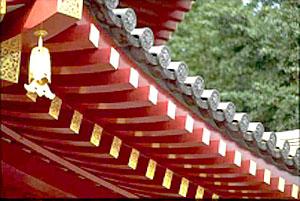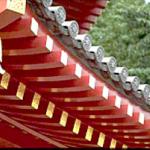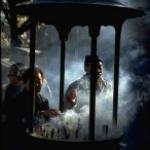Temple or Shrine?...Which is it?
Shrines and Temples. Temples and Shrines. There are countless thousands of them, both large and small, throughout Japan, and no trip would be complete without a visit to several (if not several dozen) of each. But to the uninitiated Japan traveler, the terms shrine and temple may seem to be interchangeable, when they are indeed quite different in both appearance and purpose.
To understand the difference between a shrine and a temple, it helps to know that the people of Japan practice two major religions: Shinto and Buddhism. And, unlike many other religious doctrines, the two are not mutually exclusive. This means that most Japanese people engage in the rites and ceremonies of both religions on various occasions throughout the year, as well as to mark life's personal milestones. The Shinto religion is practiced in Shinto shrines, and Buddhism is practiced in Buddhist temples.
Shinto
Shinto is the indigenous religion of Japan, and its origin dates back to the earliest days of human civilization. In the epoch before recorded history, as in many other early cultures, the Japanese people formed strong family clans. Each clan had its own spiritual ideology, based on the belief that powerful deities called kami inhabit both heaven and earth. Every clan believed in its own ruling kami, as well as in kami spirits that reside in every geographic region, and even in the elements of nature itself, such as trees, rocks, rivers and mountains. The clan relied upon a shaman or diviner to aid them in appeasing and communicating with the kami.
As the imperial Tenno clan, from which Japan's present emperor is descended, grew in power, its mythology became the foundation for the establishment of Shinto as a unified religious ideology. By the sixth century, around the same time the Chinese writing system was adopted by the people of Japan, the Shinto religion had a name. The Japanese called it kami no michi (the way of the gods), the Chinese pronunciation of which is shin tao.
And although Shinto has no official founder, no ancient sacred scriptures, and no prescribed catechism, in the eighth century, between the years 712 and 720, the essential Shinto mythology was compiled into two texts titled Kojiki (Records of Ancient Matters) and Nihongi - Nihonshoki (Chronicles of Japan). These texts contain descriptions of the creation of the world by the kami of life and fertility, Izanagi and Izanami, the rise of the sun kami Amaterasu, as well as the pantheon of lesser kami, and the Tenno family lineage as they descended from the heavenly hosts.
Architecture in Japan also began with Shinto shrines, simple rectangular structures with upright wooden supports, pitched gables and crossbeams covered with deeply thatched rice straw. The sacred grounds upon which they are built are called jinja. The shrine itself is enclosed with a surrounding wall and is accessed through a torii gate, often painted bright red and composed of two simple pillars with two horizontal lintels, which marks the passage from the mundane world into the realm of the transcendent. Inside the enclosure, a water trough called a temizuya is provided for purification before entering the main sanctuary, called the honden, which houses the shintai, the sacred image of the resident kami. Only shinshoku, Shinto priests, are allowed into the honden. Other visitors are restricted to an ante-room called the haiden.
Two lion-like komainu figures called a and un are often seen guarding the path to the shrine, and some shrines include a special pavilion called the kaguraden for the performance of sacred dances.
Shinto shrines usually face toward the south, or sometimes east, but never north or west. They are built of wood from hinoki trees, a variety of Japanese cypress, and are often surrounded by groves of sakaki trees (cleyera ochnacea), a kind of broadleaf evergreen that bears large black berries.
The Shinto religion is devoted to the affairs of worldly existence, and the rites and beliefs of ancient times are still inherent in the performance of present day Shinto ceremonies. Offerings of food and other gifts are often made to the resident kami as a gesture of gratitude or supplication by priests and visitors, who summon the resident kami by clapping their hands and tugging on a thick rope attached to a bell. Many ceremonial rites are held in honor of the agricultural seasons, and the drone of Shinto priests can often be heard as they chant their sutras in homage to the presiding kami.
And for a few hundred yen, most shrines offer little slips of paper called omikuji with fortune-telling messages printed on them. Those omikuji portending unfavorable predictions are tied to a tree or bush on the temple grounds in hopes that the resident kami will protect the unfortunate recipient from harm.
Four other important life events also take place at shrines: Tanjo, the blessing and dedication of a newborn child; Shichi Go San, the blessing of children aged seven, five and three; Seijin Seki, Coming of Age Day for young people turning 20 years old; and Kekkon, the marriage ceremony. The most lively and elaborate event of all is the annual Omikoshi Matsuri, in which the sacred shintai image of the kami is placed in a portable shrine and paraded through the streets on the shoulders of the local patrons.
There are more than 90,000 Shinto shrines in Japan, the most famous and important of which include:
Ise Jingu - The Grand Shrines of Ise, located on the Shima Peninsula on the Pacific coast of Honshu, east of Kyoto and Osaka. This holiest of all places in Japan is the site of the first Shinto shrine and the spiritual enshrinement of all Japan's emperors. The jingu is comprised of over 100 shrines, including an Outer Shrine called Geku, built in the fifth century, and the Inner Shrine called Naiku, built in 260 A.D. Naiku houses the Sacred Mirror, one of the Three Imperial Regalia of Japan, given by the Sun Goddess Amaterasu to her grandson Ninigi no Mikoto when he descended to reign over earth. According to tradition, the Ise Shrines are completely rebuilt every 20 years, and although visitors are allowed on the premises, only members of the Imperial family are allowed inside Gekuand Naiku.
Meiji Jingu - An enormous edifice located in the downtown Tokyo suburb of Shibuya, built at the turn of the 20th century to honor the Emperor Meiji and the restoration of the imperial throne.
Heian Shrine - The Shrine of Peace and Tranquility, located in the heart of Kyoto, built in 1895 to celebrate the 1100th anniversary of the founding of Kyoto and dedicated to its founder, Emperor Kammu and to Emperor Komei, father of Emperor Meiji.
Atsuta Shrine - The second most important shrine in Japan, located in the city of Nagoya, it houses Kusanagi no Tsurugi, the Sacred Sword, one of the Three Imperial Regalia, used by Prince Takeru Yamato in the third century to mow down a field of grass set ablaze by his enemies.
Kasuga Shrine - One of Japan's most famous Shinto shrines, located on a hilltop in the ancient city of Nara, just outside Kyoto. Tame deer meander along the wooded path leading up to the shrine, which is lined with 10,000 stone lanterns.
Buddhism
Although Shinto is the original religion of Japan, Buddhism was introduced from China and Korea in the sixth century. It gained more widespread acceptance in the seventh century when the Imperial Crown Prince Shotoku (537-621) became an advocate of the new ideology. But even with the sanction of the imperial family, the powerful Mononobe clan opposed Buddhism, declaring it incompatible with Shinto beliefs. Nevertheless, with continued imperial advocacy, Buddhism was adapted to Japanese culture, and temples were constructed all over Japan for its practice. Around the beginning of the ninth century, Buddhism diverged into two sects, led by Dengyo Daishi (767-822) of the Tendai sect of Mt. Hiei near Kyoto, and Kobo Daishi (774-835) of the Shingon sect of Mt. Koya near Osaka.
Over the next 400 years, the growing power of the Tendai and Shingon sects led to eventual corruption, until the beginning of the Shogun Era, when the rigorous practice of Buddhist asceticism by the samurai led to the reform of the status quo and the formation of four new sects: Jodo founded by Honen, Jodo-Shin-shu founded by Shinran, Zen founded by Eisai and Dogen, and Hokke founded by Nichiren.
The turbulent times of the shogunate, along with the introduction of Christianity by the Portuguese in the 16th century, brought about a return to Shintoism by the common folk, and in 1868, with the fall of Tokugawa, the last shogun, and the restoration of the sovereignty of the emperor Meiji, Shinto was once again declared the national religion of Japan. Nevertheless, because of its role throughout much of Japan's history, Buddhism remains an integral part of everyday life, with most Japanese people practicing both religions, each for a different purpose. Shinto is the religion of earthly matters, and Buddhism is the religion of the spiritual realm and the afterlife. Therefore, such ceremonies and rituals as weddings, the blessing of children, and prayers for success in business usually take place at Shinto shrines, whereas funeral ceremonies and rites of homage to deceased ancestors are held at Buddhist temples. On New Year's eve, the people of Japan stay up to hear the 108 tolls of the temple bell, and on New Year's Day, they almost always pay a visit to a shrine or temple.
In addition to New Year's Day, another important Buddhist observance is the season known as Obon, in which the spirits of deceased ancestors return to the land of the living. Celebrated in mid-summer, in either July or August, depending upon the region, the streets are lit with paper lanterns to mark the way home for returning spirits. Dances called Bon Odori are performed in public parks and temple gardens, gravesites are cleaned and tended, and special meals are prepared, with places set at the table for departed loved ones.
In the sixth century, the advent of Buddhism in Japan also brought the influence of more elaborate Chinese architectural style to its temples, including stone foundations, sturdy pillars to support lofty ceilings and decorative tiled roofs, all embellished with brilliant paint and other architectural detail. Therefore, by comparison, Buddhist temples are considerably more ornate than their austere Shinto counterparts.
There are thousands of temples in Japan, some of which contain the world's largest and most beautiful images of Buddha. Among the most famous and important:
Sensoji (Asakusa Kanon) - Sensoji Temple is located in the Asakusa District of Tokyo. Legend has it that, on the 18th of March in the year 628 A.D., two fishermen, Hamanari Hinokuma and his brother Takenari, cast their nets into the Sumida River and pulled out a golden statue of the Kannon Buddha. Soon thereafter, the village chief Hajino Nakamoto turned his home into a temple to house the treasured icon. Also known as Asakusa Kannon, Sensoji is Tokyo's oldest temple.
Todaiji - Located in the town of Nara outside Kyoto, the main building houses the Great Buddha of Nara. Completed in 752, the statue is the largest bronze Buddha ever cast; and Todaiji, the temple that encloses it, measures 160 feet tall, which makes it the world's largest wooden structure.
Ryoanji - Located in the heart of Kyoto, famous for its raked sand and stone garden. The name Ryoanji means Temple of the Peaceful Dragon, and the original site of Ryoanji Temple is over a thousand years old. The garden itself was added during a restoration of the site in 1488. It measures thirty meters long by ten meters wide and is comprised of fifteen natural stones of various sizes placed on a bed of pure white gravel, raked into meticulous patterns around the stones. Ryoanji is a year-round magnet for tourists, both domestic and international, and is one of the most striking and treasured landmarks in all Japan.
Kyomizu - Known as the Temple of Clear Water, located in the city of Kyoto. Founded at the source of the Kizu River by a Buddhist monk named Enchin, Kyomizu sits high atop a hill overlooking Kyoto and is renowned for its three freshwater fountains, which are believed to have healing powers.
Kinkakuji - The Temple of the Golden Pavilion, one of the most beautiful and famous temples in all Japan, located in the city of Kyoto. Originally a retirement home built for the shogun Ashikaga Yoshimitsu (1358-1409), this three-story pavilion is completely covered in gold leaf and overlooks a magnificent reflecting pool. On Yoshimitsu's death, the building was dedicated as a Buddhist temple named Rokuonji. More than five centuries later, in 1950, a priest set fire to the temple. The golden pavilion that stands on the site today is an exact replica.
Horyuji - Located in the town of Nara, this seventh-century temple was founded by Prince Shotoku. Unlike so many of Japan's other historical buildings, the original structure has remained intact since its construction in 607, making it the world's oldest wooden building.
Kamakura Daibutsu - Located in the tiny hamlet of Kamakura just south of Tokyo, the Dai Butsu at Kamakura was once housed in an enormous wooden temple, until 1495, when a tsunami washed it away, leaving the massive bronze statue exposed to the elements for more than five hundred years.
Shrine and Temple Do's and Don'ts
Shrines and temples are highly sacred places and therefore one should always maintain an attitude of reverence and respect when on the premises. Assuming an air of humility and transcendence also helps heighten the experience of your shrine or temple visit. And a little advance research on the history of the one you are visiting will greatly enhance your understanding and enjoyment.
When visiting a Shinto shrine or a Buddhist Temple:
Do maintain an attitude of reverence at all times.
Do observe and follow the behavior of other visitors.
Do rinse your hands and mouth at the temizuya for purification.
Do stop to light a bundle of incense at the brazier and fan the smoke toward your face.
Do remove your shoes at the entrance. (It's okay to leave your socks on.)
Do clap your hands and tug the rope to summon the kami.
Do say a prayer of thanks, penitence, or invocation.
Do make an offering of money.
Do buy a souvenir or an omikuji for good luck.
Do rubberstamp your dictionary or notebook with the shrine or temple emblem.
Do take photographs where permitted.
Do ask questions of guides and attendants.
When visiting a shrine or temple:
Don't horse around or speak in a boisterous tone of voice.
Don't wander into unauthorized areas.
Don't touch artwork or decorations.
Don't pick any flowers or foliage.
Don't help yourself to any rocks, stones, wood, hardware or other "souvenirs."
Don't climb or sit on gates, fences, walls, trees, etc.
Don't take photographs in unauthorized areas.
Don't disturb the resident priests.
So... to tell the difference between a shrine and a temple, remember that you always enter a Shinto shrine through a torii gate, and a Buddhist temple always houses an image of the Buddha. Another telltale indicator is the suffix attached to its name. The names of Shinto shrines use the suffix jingu, and Buddhist temples usually have the suffix ji.
And whatever you do or don't do when you visit a shrine or a temple, be sure to make the most of your visit to Japan by visiting as many of them as your time there allows. Each and every one is imbued with the deepest elements of Japan's history and is steeped in the very essence of the Japanese people. And no matter what your religious persuasion happens to be, a visit to a Shinto shrine or a Buddhist temple is always a balm for the soul.
* * * * *
 ThingsAsian
ThingsAsian



















